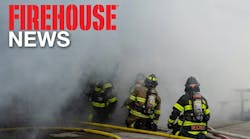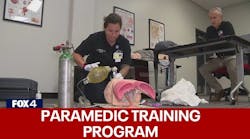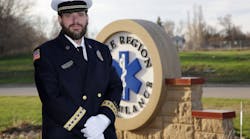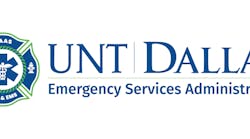Jake Fuller was studying to become a teacher, following in the career path of his parents, when he decided the profession wasn’t exactly what he had in mind. He sought something that was physically challenging, valued by the community and included an academic degree. That’s when he discovered, by way of a coworker, the University Montana-Helena Fire and Rescue Program. The former graduate of the program is now a senior firefighter at Missoula Rural Fire District (MRFD) – and teaches in the program.
“I was on a career path, but wanted to change direction. And that’s what the U of M-Helena program offered. I wanted to have the degree. I also wanted to find a route to get into the fire service. In Montana, this program was the best option for me,” he says. After graduation, Fuller moved to Missoula and began as a “resident” firefighter at MRFD, which put him in good stead when a job opened 10 months later. Today, Fuller is a senior firefighter and avid proponent of the program.
Mike Wiederhold, coordinator of the University of Montana-Helena Fire and Rescue program, says his program is an effective route for students seeking technical and academic credentials to land them a job in the fire service.
“If it weren’t for our program it might be very difficult for an individual to gain an avenue to find a position in a career fire department in Montana. Because students learn in the program what they need to know to do the job. All of our instructors are active firefighters. It’s really a two-year interview process. You’re being taught by individuals who will be part of the hiring process so that when you’re done with the two-year program they know a lot about you,” he says. “We are a two-year career college under the University of Montana-Helena College of Technology. Our fire and rescue program has been in operation for 14 years. We offer two-year programs in associate of applied science and see approximately 40 students per year at our Helena and Missoula campuses.”
Residency program gains popularity
The residency program U of M-Helena employs is gaining in popularity nationwide. It varies in some aspects from station to department, but it involves placing students in firehouses, much as interns in business. Students are given a shift schedule to follow and are expected to demonstrate their proficiency of training on emergency calls. This is a tremendous resource for the community and students. Fire departments, many long struggling for adequate staffing, find the program as at least a partial solution to manpower needs. Of course, students find the practical experience invaluable as they apply classroom theories on the street.
“Our resident program is currently a two-year term available to current students and others. As a combination fire department (MRFD), we are highly supplemented by volunteers and residents,” Fuller says. “These individuals have live-in quarters in a fire station and they work shifts. They are assigned 12-hour shifts. It’s one of the few opportunities in our part of the world to gain a hands-on experience in a fire station and learn the fire department culture. There is no bigger bang for your buck than earning your degree while obtaining the experience preparing for this industry during that two-year period.”
When he was a prospective student, Fuller says, he welcomed the applied portions of the curriculum. “The biggest draw for me was that it was a hands-on experience – not just academics.” Student evaluations bear this out. “Currently, the job training is a great selling point for us,” Fuller says. “But we offer both the training ground aspect of a fire academy in conjunction with academics.
“Almost across the board we hear from successful students – ones who have attained jobs – how oftentimes they had to remind themselves that there were in school. They were out doing what they considered fun activities for college credit. I also hear that students didn’t expect the academics and the level of higher education expectations we have for them. Many new students arrive here and want to be hose draggers and heroes – hanging from ropes and so on. We stress to our students that we are looking for smart guys as well guys who get it done in the field as well as on paper,” Fuller says.
The four-semester-long program not only meets minimum standards as set forth by National Fire Protection Association (NFPA) 1500, 1582, in 1901, academics are emphasized too. A sampling of non-fire courses required of students include Introduction to Technical Writing, Electronic Communications, Technical Mathematics and Career Development in Human Relations. Also integrated in the program is EMT-basic.
Wiederhold says, “What I’ve heard from our advisory council is that they desire students who have better math and English skills. They want them to be able to communicate well, do math…If you look at the leadership in the fire service, they are becoming more educated. They are running big budgets; they are truly CEOs. So when today’s fire service leadership looks at the folks coming up in their departments, they are expecting those skills too.”
The promise of community colleges
The U.S. has more than 1,600 community colleges with some 5.5 million students enrolled in a variety of academic and technical endeavors. Once called junior colleges, these institutions were created to provide a bridge to the university system. Others saw these two-year institutions as America’s democracy colleges, opening their doors to students who otherwise would not have been afforded the opportunity of higher education. With the rising tuition rates at four-year institutions, community colleges continue to provide access to a diverse population, delivering vocational education to meet local, state and national economic demands.
The Truman Commission, shortly after World War II, provided a prominence to community colleges, extending educational opportunities to returning GIs who were encouraged to attend college by the GI Bill. The Presidential Commission found, “the community college seeks to become a center of learning for the entire community with or without the restrictions that surround formal coursework in traditional institutions of higher education. It gears its programs and services to the needs and wishes of the people it serves.”
This acclamation and surging enrollments fired the fervor of community colleges in the 1960s. This rapid transformation of higher education saw just about one community college built per week in the 1960s with some 1,000 community colleges operating in every state, boasting an enrollment of 2.5 million students by the fall of 1970.
The line between academic and technical education and training is less defined as it once was. In the first two decades of the 20th century, two-year institutions succeeded in granting students university transfer. Some have argued that the “vocationalization” of community colleges should be a goal to attain. Yet statistics show that one out of every two community colleges is developing service-learning programs, whose mission is to combine formal instruction with a related community service. This can take on many permutations, firefighting certainly one of those. Service learning doesn’t end with a vocation; some see it as a way for students to develop vital skills such as critical thinking, quantitative reasoning, written and oral communication and the role of self and community.
Preparing for the real world
Natalie Hannum, department chair and assistant professor at Moreno Valley College in California, sees her institution’s goals based in technical proficiency, academic preparation and community service.
“Community colleges, Moreno Valley College included, provide affordable options for students,” she says. “By integrating service learning, vocational skills and basic skills education, employers are getting well-rounded candidates and students are getting a well-rounded education. We hear from the firefighting industry that candidates today need to have better ‘soft’ skills such as manners, etiquette, appearance, customer service skills and intuitive abilities to work with others. Service learning is a great way to advance a student’s soft skills in these areas.
“Additionally, some students come to the community college environment not yet academically ‘mature.’ What I mean by this is that they are not yet confident in their academic ability. Community colleges offer an opportunity for their course work to be contextualized around topics in which they are interested, and therefore the student becomes more motivated to learn. Once a student achieves some academic success, they become more confident to take on other more challenging courses. As far as basic skills, we emphasize that they are essential for overall career success and longevity. In Fire Technology, we embed basic skills throughout the career and technical education experience. Integrating reading, writing, math and critical thinking is a natural fit for the firefighting profession, and we try to do so at every turn explaining to the students and cadets how these skills directly apply to their future. We explain that it is not enough to be simply physically strong, but rather you have to be physically and academically fit.”
Basic training for student firefighters
At Moreno Valley College, the Ben Clark Training Center, which is owned by the Riverside County Fire Department and local law enforcement agencies, offers a basic firefighter academy during its 12-week program. College credit is earned and may be applied to an associate’s degree and transferred to select California four-year colleges and universities. Hannum says the discipline is “an accredited state fire training program. It offers a fire academy and associate’s degree in fire technology. Our curriculum also offers a concentration in our chief officer series. We have four different options for associate’s degrees.
“We run three fire academies every year, which can accommodate between 90 and 100 students. Students receive the NFPA standard for Firefighter I, which meets the curriculum set by our state training office here in California. When they complete our training, they still need to do some field training before they can apply to the state for their State of California Firefighter I certificate. When students finish they will have more than 350 hours of instruction. It’s a 12-week academy – 6 A.M. to 6 P.M. We require participants be state-registered EMT’s prior to entry in the academy along with a physical agility exam.”
“In the community college system in California, a student must complete a minimum of 60 units and sometimes a little bit more depending upon their general education options to achieve an associate’s degree. They must take all of the program requirement courses and the general education requirements for their degree.”
University transfer in California is not as simple as in other states. Two-year institutions are able to place associate’s-level students at some institutions; others are not eligible for transfer. “There are certain institutions in California that offer 2+2 programs, Hannum says. “This allows students who get their associates to transfer, to say, Cal State-LA where there is a fire administration bachelor’s degree.
“We have a very close working relationship with our county training officers along with our advisory committee, which are made up of members of local fire departments. Where that relationship has been really helpful is in our needs assessment. Riverside County Fire Department officials assess what their manpower needs are. And then we try to schedule our admissions accordingly.”
Partnership pays off for students and agencies
At the heart of the Moreno Valley College program is the Ben Clark Training Center. “Much of what we do could not take place without their equipment and assistance,” Hannum says. “Through a contractual agreement we have use of this facility. But what’s really important is the relationship and working with the department and knowing what their needs are.”
Conversely, students in the Moreno Valley College program had the advantage of county fire officials available to them as coaches and mentors. Although Hannum points out that the college does not place students in jobs; it is their responsibility to seek employment, the working relationship between the college and fire department is a formidable asset. “We try to prepare students in what to expect in interviews and in the hiring process as they seek a jobs in the workforce.”
Most firefighting jobs in California require a specific California credential, Hannum says. “Many departments in California require that Firefighter I is achieved from an accredited academy such as ours as a condition of employment. Because there are multiple ways to get a job as a firefighter, it can be confusing to the student in choosing the best pathway to obtain employment. Sometimes it’s good to get a reserve firefighter job and work through the Firefighter I checklist as a route to getting a career job.”
The teaching is structured as well as the culture in which it is presented. “We have a paramilitary culture; and we enforce that culture even in our core classes,” Hannum says. “We require students to act accordingly – by addressing their superiors according to rank and last name. It might seem a little old fashioned, but I’ve had parents contact me asking, ‘What you done to my child?’ ”
The associate’s program has a standardized curriculum throughout the state, which is a major advantage to students and instructors alike. “I’m in Southern California near the city of Riverside. A student begins her career in the northern end of the state and for whatever reason they end up relocating here,” says Hannum, a former firefighter. “We accept their Firefighter I certification and courses just like they got them here. It also tells employers that perspective employees have met a certain standard of curriculum. It puts all of the community colleges here in California on the same page.”
Regardless the outcome of employment in a highly competitive market for firefighters, Hannum sees other values when students achieve an associate’s degree from Moreno Valley College. “What I think is really important for any student,” she says, “is that they can show completion by going through the program; and that dedication shows a lot to any employer.”
PAUL SNODGRASS, a Firehouse® contributing editor, is a former fire chief with 19 years of fire service experience. He is an adjunct fire service instructor at Hillsborough Community College in Tampa, FL, and Cogswell College in Sunnyvale, CA. Snodgrass holds a bachelor’s degree in political science from Augsburg College in Minneapolis, MN, and a master’s degree from the University of Phoenix. He has been writing about, designing and teaching traditional and online courses since 2005. He can be contacted at [email protected].






